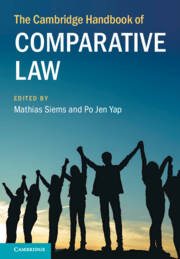Book contents
- The Cambridge Handbook of Comparative Law
- The Cambridge Handbook of Comparative Law
- Copyright page
- Contents
- Figures
- Tables
- Contributors
- Preface
- Abbreviations
- 1 Introduction
- Part I Methods of Comparative Law
- Part II Legal Families and Geographical Comparisons
- Part III Central Themes in Comparative Law
- 19 The Tradition of Comparative Law: Comparison and Its Colonial Legacies
- 20 Decolonial Theory and Comparative Law
- 21 Legal Transplants: A Theoretical Framework and a Case Study from Public Law
- 22 Legal Transplants: A Case Study of Private Law in Its Historical Context
- 23 Convergence and Divergence in Public Law
- 24 Convergence and Divergence in Company Law
- 25 Law and Development
- 26 Divided Legal Systems
- 27 Legal Pluralism and Commerce
- Part IV Comparative Law beyond the State
- Index
22 - Legal Transplants: A Case Study of Private Law in Its Historical Context
from Part III - Central Themes in Comparative Law
Published online by Cambridge University Press: 26 January 2024
- The Cambridge Handbook of Comparative Law
- The Cambridge Handbook of Comparative Law
- Copyright page
- Contents
- Figures
- Tables
- Contributors
- Preface
- Abbreviations
- 1 Introduction
- Part I Methods of Comparative Law
- Part II Legal Families and Geographical Comparisons
- Part III Central Themes in Comparative Law
- 19 The Tradition of Comparative Law: Comparison and Its Colonial Legacies
- 20 Decolonial Theory and Comparative Law
- 21 Legal Transplants: A Theoretical Framework and a Case Study from Public Law
- 22 Legal Transplants: A Case Study of Private Law in Its Historical Context
- 23 Convergence and Divergence in Public Law
- 24 Convergence and Divergence in Company Law
- 25 Law and Development
- 26 Divided Legal Systems
- 27 Legal Pluralism and Commerce
- Part IV Comparative Law beyond the State
- Index
Summary
There can be little doubt that foreign law has influenced the development of South American private law and that this continues to be the case nowadays. However, this chapter shows that even from the earliest stages of their historical development, these states did not merely copy legal solutions created elsewhere when receiving foreign influences. We adopt a historical perspective and a broad notion of legal transplants to expose foreign law’s influence over the shaping of South American private law and critically evaluate some dominant narratives. First, we analyse the various ways they have influenced the drafters of South American Civil Codes throughout the different waves of codification, as well as the strategies adopted. Afterwards, the inquiry moves to some particular subjects of South American contract law and traces various key shifts that occurred when shaping a liberalisation which, during the nineteenth century, went further than the contemporary European legislation: for instance, taking inspiration from Bentham. After that, we show an inverse movement during the last decades of the twentieth century, directed towards developing a more social conception of contract law, inspired mostly by the German and Italian Civil Codes, though not followed by all jurisdictions. It is concluded that although different European legal systems have informed South American private law, the result is an original blend that is a product of both the creative character of the solutions and the inspiration taken from sources not usually adopted elsewhere in the field of legal transplants.
Keywords
- Type
- Chapter
- Information
- The Cambridge Handbook of Comparative Law , pp. 453 - 474Publisher: Cambridge University PressPrint publication year: 2024
- 1
- Cited by

